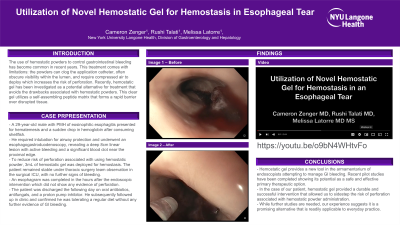Sunday Poster Session
Category: Endoscopy Video Forum
P0386 - Utilization of Novel Hemostatic Gel for Hemostasis in an Esophageal Tear

- CZ
Cameron Zenger, MD
NYU Langone Health
New York, NY
Presenting Author(s)
NYU Langone Health, New York, NY
Introduction:
The use of hemostatic powders to control gastrointestinal bleeding has become common in recent years. This treatment comes with limitations: the powders can clog the application catheter, often obscure visibility within the lumen, and require compressed air to deploy which increases the risk of perforation. Recently, the hemostatic gel has been investigated as a potential alternative for treatment that avoids the common drawbacks associated with hemostatic powders. This clear gel utilizes a self-assembling peptide matrix that forms a rapid barrier over disrupted tissue.
Case Description/Methods:
A 29-year-old male with a past medical history of eosinophilic esophagitis and known esophageal tear, non-adherent to treatment, presented to the hospital with hematemesis and acute hemoglobin drop after ingesting shellfish. The patient was intubated for airway protection, and esophagogastroduodenoscopy was performed demonstrating an 8cm deep linear lesion with active oozing and a large blood clot along the proximal edge. Given the friable nature of the esophagus and long, deep tear, there was concern for inducing a treatment-related complication through the delivery of compressed air with hemostatic powder, hemostatic gel was applied. The patient was extubated following the procedure and monitored by the thoracic surgery team in the surgical ICU following the procedure, where he remained hemodynamically stable without further clinical or laboratory evidence of bleeding. An esophagram was completed in the hours after the endoscopic intervention which did not show any evidence of perforation. The patient was discharged the following day on oral antibiotics, antifungals, and a proton pump inhibitor. He subsequently followed up in clinic and confirmed he was tolerating a regular diet without any further evidence of GI bleeding.
Discussion:
Hemostatic gel provides a new tool in the armamentarium of endoscopists attempting to manage GI bleeding. Recent pilot studies have been completed showing its potential as a safe and effective primary therapeutic option. In the case of our patient, it provided a durable and successful intervention that allowed us to sidestep the risk of perforation associated with hemostatic powder administration. While further studies are needed, our experience suggests it is a promising alternative that is readily applicable to everyday practice.
Disclosures:
Cameron Zenger, MD, Rushi Talati, MD, Melissa Latorre, MD. P0386 - Utilization of Novel Hemostatic Gel for Hemostasis in an Esophageal Tear, ACG 2023 Annual Scientific Meeting Abstracts. Vancouver, BC, Canada: American College of Gastroenterology.
